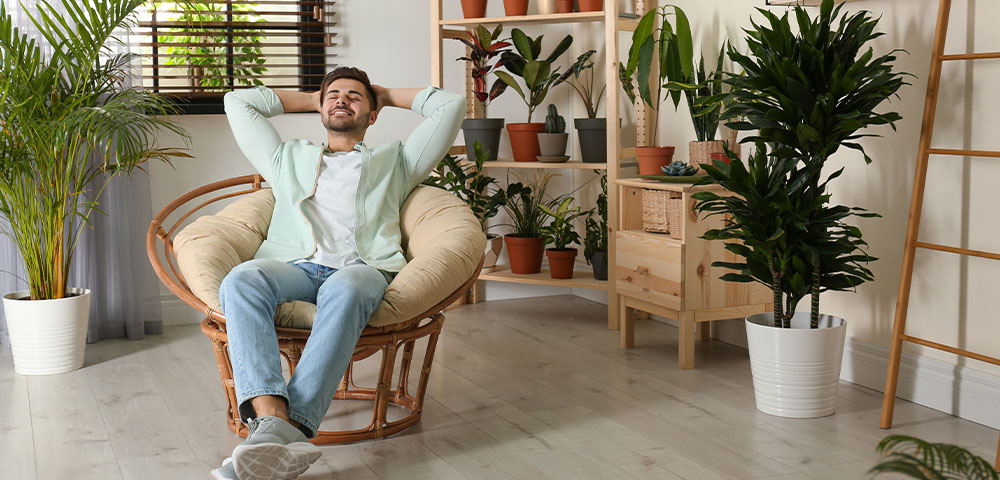In the North Dakota winter, the amount of sunlight we get dips down to as little as eight hours a day. Combine the dark with cold temperatures that encourage us to coop ourselves up indoors, and we’re susceptible to a type of depression called Seasonal Affective Disorder (SAD).
The good news is there are lots of ways to prevent SAD. One way is houseplants! Here’s how to prevent SAD with calming indoor plants, along with some SAD facts and straightforward preventative measures that are important to practice alongside plant therapy.

What is Seasonal Affective Disorder (SAD)?
SAD is a type of depression related to the seasons. For most people, it sets in during the fall or early winter and goes away in the spring. Symptoms of SAD include:
- Feeling depressed most of the time
- Trouble sleeping (oversleeping or insomnia)
- Lack of energy and motivation
- Trouble concentrating
- Feeling agitated, anxious, irritable, or stressed out
What Causes SAD?
The causes of SAD are still unknown, but the prevailing theory about winter-onset SAD is that it’s caused by reduced sunlight. This theory is backed up by the fact that SAD occurs more frequently among people who live in places like North Dakota, which are far away from the equator, and receive much less sunlight in the winter.
Even just 10 minutes of sunshine a day can have significant benefits for your health!

3 Ways to Prevent SAD Alongside Plant Therapy
Get some sunlight every day. Even just 10 minutes of sunshine a day can have significant benefits for your health. If you don’t have indoor places where you can bask in the sunlight, bundle up and get outside! The fresh air is good for you, too. Here are some ideas for how to enjoy the outdoors:
- Go for a brisk walk at lunchtime. (Exercise also prevents SAD.)
- Take up a winter activity like skating, skiing, or ice fishing.
- Got any kids in your life? Take them sledding!
Exercise. Exercise reduces your stress levels and improves your mood by causing your body to release endorphins and boost brain chemicals like dopamine and serotonin. Even just a brisk half-hour walk every day can do wonders.
Keep in touch with friends and family. There’s nothing like a chat or a visit to lift your mood. Try to get one in every day, if you can! Also, make sure you have face time and verbal contact if you can’t visit in person. These forms of interaction have a higher impact on us than just words on a screen.

Indoor Plants That Help With Depression and Anxiety
And now, what we’ve been waiting for: how plants enter into the picture to help prevent SAD. What indoor plants help with depression and anxiety? All of them! Here’s why:
- Research has shown that surrounding yourself with lush greenery and bright flowers helps to lift your mood. It’s also a wonderful way to revitalize homes and workspaces.
- Houseplants are like pets—they make us feel important because they depend on our care to thrive. When depression makes you feel sad or insignificant, tending to your plants makes you feel productive and gives you a purpose.
- Even potting soil can help with reducing stress and anxiety because it contains microbes (M. vaccae) that are natural antidepressants.
Some calming indoor plants particularly renowned for their abilities to help with depression and anxiety include:
- Chamomile (you can make a calming tea with it)
- English ivy (especially good for alleviating asthma and allergies)
- Gerbera (air purifier with gorgeous flowers)
- Jasmine (known for its soothing aroma)
- Lavender (also known for its soothing aroma)
- Peppermint (a refreshing herb that can live outside in the summer)
- Rosemary (another herb with a refreshing scent)
- Snake plant (air purifier that thrives in low light)
How to Get Started With Plant Therapy
If you’re new to looking after houseplants, we recommend you start with ones that don’t mind a bit of neglect. We carry plenty of low-maintenance plants that can help prevent SAD at our garden center, and we’d be happy to help you pick a few out.

Indoor Plants That Thrive in Low Light
You also need to consider what houseplants will be able to thrive in the light conditions of your home, especially during the winter when there aren’t many daylight hours. Houseplants that are still full of life in low light include:
- Peace lily
- Philodendron
- Pothos
- Rex begonia
- Snake plant
- ZZ plant

What Plants Help You Sleep?
Getting enough sleep is another important way to help prevent SAD. There are several calming indoor plants that can help you sleep.
If you like scents, get a potted lavender or jasmine. These plants and their aromas are especially good at helping you relax and let go of stress and anxiety.
Or, try plants that purify your air. Air-purifying plants help to improve the quality of your sleep by ridding your home of allergens, mold, and pollutants from synthetic materials while pumping oxygen, and sometimes moisture, into the air. They can even eliminate odors.
Air-purifying plants include:
- Boston fern
- Devil’s ivy
- Dracaena
- English ivy
- Gerbera
- Peace lily
- Philodendron
- Pothos
- Snake plant
- Spider plant
Visit Us for a Perfect Combination of Plant and Retail Therapy
Plants brighten your home and your mood all year long, but anyone looking to prevent seasonal depression will especially appreciate them during the dark, cold winter months. Surround yourself with your favorite plant friends as a much-needed reminder that winter doesn’t last forever, and visit us at the greenhouse for a little combination of plant and retail therapy!

